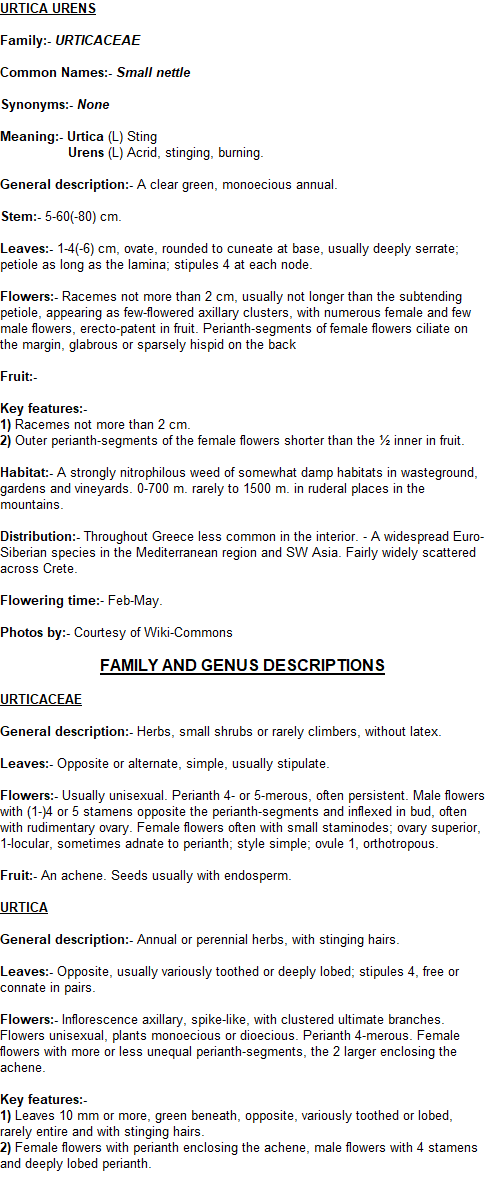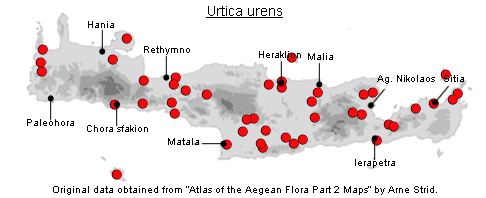SPECIES DESCRIPTION


MEDICINAL AND HERBAL USES, MYTHOLOGY AND FOLKLORE
Researched and written by Enda McMullen
URTICA MEMBRANACEA
Not too many people would think of nettles as “Flowers of Crete”. Nevertheless, this currently flowering plant plays an extremely important role in maintaining bio-diversity by providing an all-important source of food for a number of insects and larvae around the place. Nettles are also an indicator of good, healthy soil. Keeping nettles in check is not that difficult, destroying them is a far more of a difficult (if not impossible) task, and not a good thing to do.
There are about 35 species in the genus Urtica, some of which can grow up to 300 cm. Three of these are present on Crete, Urtica membranacea, Urtica urens and not so common Urtica pilulifera. Differentiating between the 3 species is not too difficult. Urtica membranacea also known as the "large-leaved nettle", while Urtica urens is commonly known as “stinging nettle”, and is taller. Uritca pilulifera is the tallest of the three, growing up to 100 cm in height. Don’t let the name “stinging nettle” mislead you, all three sting!
Comparing the severity of the sting is the hard way of finding out the difference between the species. While the sting of the dwarf nettle and the stinging nettle are painful, but don’t give too much long-term discomfort, the sting of the seriously venomous Roman nettle is a totally different experience… There is of course also Lamium, or deadnettle, which is not a true nettle and does not belong to the Urtica genus. It also doesn’t sting…
However, the easiest way to see the difference is to look at the flowers. Both the dwarf and stinging nettle produce white-ish plumes, with those of the stinging nettle looking distinctly more feathery than those of the dwarf nettle. The Roman nettle produce small little globes as a flower, and thus looks totally different.
Nettles are a vastly underrated plant. Not only are they edible, they are highly nutritious and versatile. Do however wear gloves when going out picking nettles… Nettle leaves can be used in salads, the herb makes and excellently refreshing and medicinal tea, and the nettle can even be used to brew nettle beer.
Urtica Urens is widely used in homeopathy and herbal medicine. One of the main homeopathic uses of nettle is the stop the flow of milk after weaning a baby and to reduce the swelling in the breasts. Another common and very effective use of the whole, fresh nettle is known as urtication, where arthritic joints are literally flogged with the stinging nettle which reduces swelling and activates movement.
Nettles are a valued medicinal food, which is very effective in combatting allergies. Eating nettle leaves is one of the most effective ways of tackling and preventing allergies, and comes without the often serious and debilitating side-effects of prescription medicine. A daily cup of tea and a dose of nettle leaf as salad twice or more a week will soon make allergies something of the past! The standard prescription is 30 days of nettle treatment before the effects become seriously apparent. The nettle root is highly effective in treating urination problems caused by an enlarged prostate. Dioscorides, John Gerard, Culpepper and many other famous herbalists have written extensively on the benefits of nettles, which were once deliberately planted in the private gardens of royalty because of their medicinal value and ease of use.
Nettle is also a very viable economic product. Known as E140, this EU labelled green food dye is nothing other than the chlorophyll of nettle. For years nettle juice which was used to produce the specific green colour of military uniforms. For centuries nettle fibre has been used to weave materials, with some of these materials found in Bronze Age graves.
In 1917, 18% of the uniforms, coats, blankets, etc for the German and Austrian troops were made from nettle, with millions of acres of land given over to the growing of the plant to supply the fibre. Blankets, clothing and many other materials were and are still made from nettle fibre, which is far more durable than the more commonly used cotton. The main advantages of nettle as an economic crop are low production cost, and no need to use pesticides.
The aptly named “Sting project”, managed by De Montfort University of Leicester engages in continued research in the use of nettle as a source material for upholstery, clothing, car-furnishings etc. Audi, Volvo, BMW and GM all use natural fibres, including nettle, in their products. In 2004 the fashion world really embraced the nettle and the first nettle based lingerie was produced in the UK.
And last but not least, a very valuable tip. When stung by a nettle, rub the stings with the juice of the nettle. It is the best anti-dote. Dock-leaf is also a good option, but not as efficient as nettle juice.
Researched and written by Enda McMullen
URTICA MEMBRANACEA
Not too many people would think of nettles as “Flowers of Crete”. Nevertheless, this currently flowering plant plays an extremely important role in maintaining bio-diversity by providing an all-important source of food for a number of insects and larvae around the place. Nettles are also an indicator of good, healthy soil. Keeping nettles in check is not that difficult, destroying them is a far more of a difficult (if not impossible) task, and not a good thing to do.
There are about 35 species in the genus Urtica, some of which can grow up to 300 cm. Three of these are present on Crete, Urtica membranacea, Urtica urens and not so common Urtica pilulifera. Differentiating between the 3 species is not too difficult. Urtica membranacea also known as the "large-leaved nettle", while Urtica urens is commonly known as “stinging nettle”, and is taller. Uritca pilulifera is the tallest of the three, growing up to 100 cm in height. Don’t let the name “stinging nettle” mislead you, all three sting!
Comparing the severity of the sting is the hard way of finding out the difference between the species. While the sting of the dwarf nettle and the stinging nettle are painful, but don’t give too much long-term discomfort, the sting of the seriously venomous Roman nettle is a totally different experience… There is of course also Lamium, or deadnettle, which is not a true nettle and does not belong to the Urtica genus. It also doesn’t sting…
However, the easiest way to see the difference is to look at the flowers. Both the dwarf and stinging nettle produce white-ish plumes, with those of the stinging nettle looking distinctly more feathery than those of the dwarf nettle. The Roman nettle produce small little globes as a flower, and thus looks totally different.
Nettles are a vastly underrated plant. Not only are they edible, they are highly nutritious and versatile. Do however wear gloves when going out picking nettles… Nettle leaves can be used in salads, the herb makes and excellently refreshing and medicinal tea, and the nettle can even be used to brew nettle beer.
Urtica Urens is widely used in homeopathy and herbal medicine. One of the main homeopathic uses of nettle is the stop the flow of milk after weaning a baby and to reduce the swelling in the breasts. Another common and very effective use of the whole, fresh nettle is known as urtication, where arthritic joints are literally flogged with the stinging nettle which reduces swelling and activates movement.
Nettles are a valued medicinal food, which is very effective in combatting allergies. Eating nettle leaves is one of the most effective ways of tackling and preventing allergies, and comes without the often serious and debilitating side-effects of prescription medicine. A daily cup of tea and a dose of nettle leaf as salad twice or more a week will soon make allergies something of the past! The standard prescription is 30 days of nettle treatment before the effects become seriously apparent. The nettle root is highly effective in treating urination problems caused by an enlarged prostate. Dioscorides, John Gerard, Culpepper and many other famous herbalists have written extensively on the benefits of nettles, which were once deliberately planted in the private gardens of royalty because of their medicinal value and ease of use.
Nettle is also a very viable economic product. Known as E140, this EU labelled green food dye is nothing other than the chlorophyll of nettle. For years nettle juice which was used to produce the specific green colour of military uniforms. For centuries nettle fibre has been used to weave materials, with some of these materials found in Bronze Age graves.
In 1917, 18% of the uniforms, coats, blankets, etc for the German and Austrian troops were made from nettle, with millions of acres of land given over to the growing of the plant to supply the fibre. Blankets, clothing and many other materials were and are still made from nettle fibre, which is far more durable than the more commonly used cotton. The main advantages of nettle as an economic crop are low production cost, and no need to use pesticides.
The aptly named “Sting project”, managed by De Montfort University of Leicester engages in continued research in the use of nettle as a source material for upholstery, clothing, car-furnishings etc. Audi, Volvo, BMW and GM all use natural fibres, including nettle, in their products. In 2004 the fashion world really embraced the nettle and the first nettle based lingerie was produced in the UK.
And last but not least, a very valuable tip. When stung by a nettle, rub the stings with the juice of the nettle. It is the best anti-dote. Dock-leaf is also a good option, but not as efficient as nettle juice.